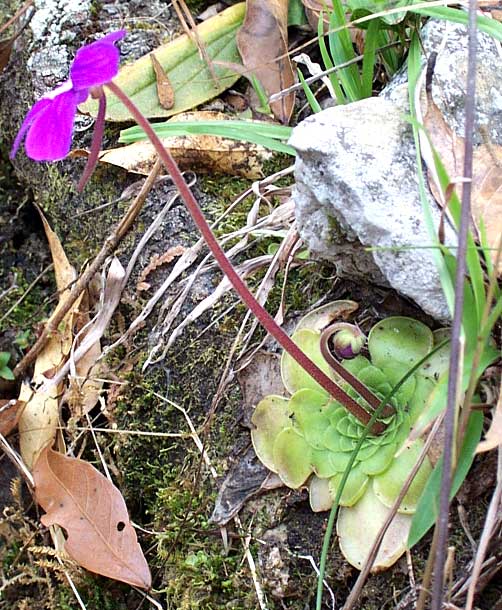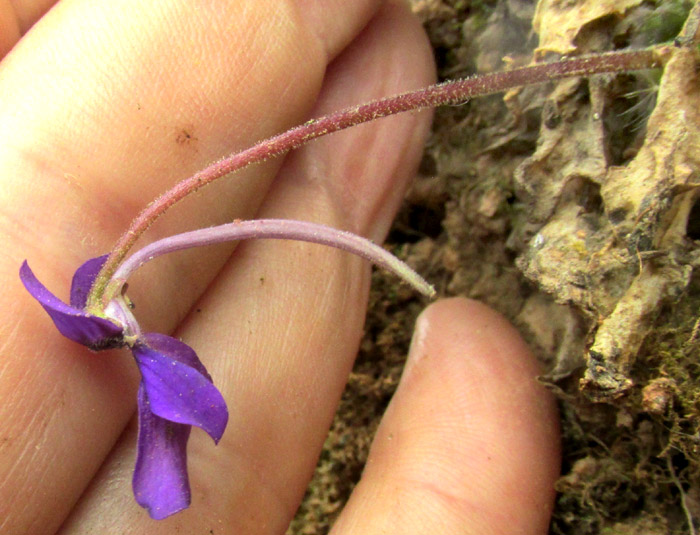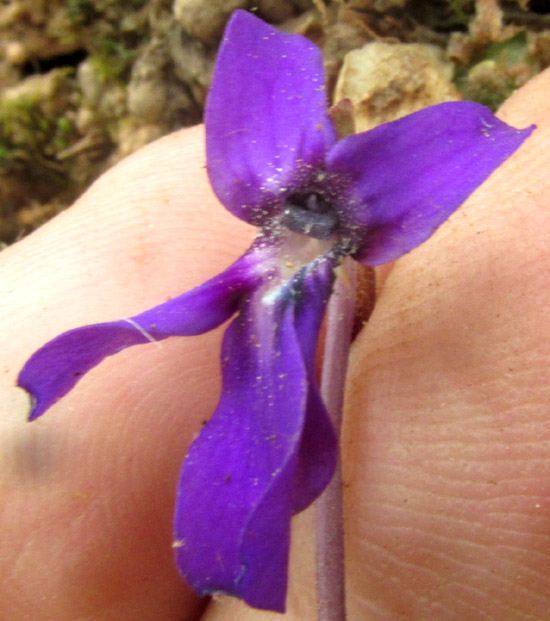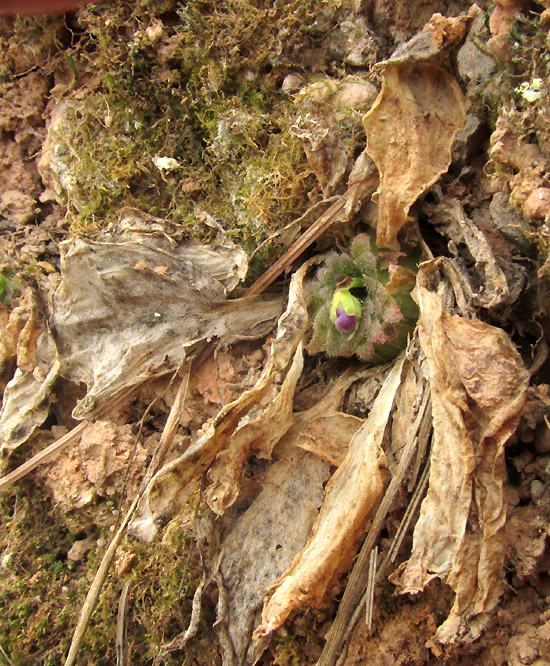Excerpts from Jim Conrad's
Naturalist Newsletter
from the March 10, 2007 Newsletter, notes from visit to oak/pine forest above San Juan de Los Durán, Sierra Gorda Biosphere Reserve, elevation ~1400m (4600ft), ~N21.47°, ~W99.17°
QUERÉTARO, MÉXICO
BUTTERWORT
One plant I always look for when I head into the higher elevations in eastern Querétaro State is the butterwort. Four Butterwort species are listed for the Reserve. A purple-flowered one is shown below:

That's PINGUICULA MORANENSIS var. MORANENSIS. In the image, notice the long, slender spur extending behind the blossom and holding nectar for pollinators with long proboscises. It almost looks like a violet flower, but the plant's leaves are very unlike any violet.
Butterworts are insectivorous plants -- they "eat" insects and other tiny invertebrates, and even plant debris that gets trapped in the abundant, gland-tipped, sticky hairs mantling the butterworts' broad leaves. The complex "eating" process is described very well on Wikipedia's Pinguicula page.
As that page explains, one feature enabling butterworts to soak up nutrients from disintegrating prey is that their pretty leaves are profusely perforated with tiny holes sometimes called cuticular gaps. These holes allow digestive secretions to be absorbed into the leaf.
You can imagine that having leaves filled with holes means that the plants can very easily dry out. That's the reason you don't find Butterworts anyplace but where the air stays humid most of the time -- as in shady sites in the Eastern Sierra Madre highlands, where rising air cools and moisture in the air often condenses. Pinguiculas here typically occur in or near mountaintop cloud forests.
Entry dated April 18, 2024, from notes taken about 1km north of Puerto de los Velazquez, Municipality of Pinal de Amoles; N21.1315°, -99.6703°, elevation ~2720 meters (~8900 feet); oak/pine forest on limestone bedrock; east-central Querétaro state, MÉXICO
BUTTERWORT

As seen above, once again a Pingicula moranensis turns up, this one clinging to a near-vertical, usually shaded wall of an old roadcut through mixed dirt and limestone rocks, kept from eroding by a dense moss carpet. This time my camera can focus close enough to show some interesting features of the butterwort flower, seen below:

Note that atop the corolla's mouth there's something like a dark-violet, rolled-backwards, two-tipped tongue. That's the two-parted stigma. Immediately below the stigma, unseen, reside the flower's two pollen-producing stamens. The conspicuous stigmas atop the corolla's mouth are useful in case you ever wonder whether you're seeing a violet flower with an exceptionally long, slender spur, such as North America's Long-spurred Violet, Viola rostrata. Violet flowers develop no such stigmas.
In the above picture, notice what appears to be white pollen grains messily scattered around the corolla's mouth. From what I read in the 2016 study by Andreas Fleishmann entitled "Pinguicula flowers with pollen imitations close at night -- some observations on butterwort flower biology," there's such a thing among butterwort flowers as pollen mimicry -- and the presence of "pseudopollen." Pseudopollen consists of pollen imitations formed by sterile outgrowths from the corolla surface. To pollen-seeking pollinators, pseudopollen advertises abundant available pollen.
Is our blossom splattered with pollen, or pseudopollen? Fleishmann's photo of pollen imitations shows a yellow heap atop the base of the lowest petal. Our photo has a yellowish speck at that location, but nothing like Fleishmann's heap. Possibly the scattered white specks are truly pollen grains. I'm unsure about the range of pseudopollen appearances.

The above image shows a nearby plant issuing an opening flower bud amid numerous thin, dried-dead leaves. Many of the 126 or so currently accepted Pinguicula species cycle between leaves which are carnivorous, and those which aren't. The 2005 Flora del Bajío description of our Pinguicula moranensis says that the species's "winter" leaves consist of (4)6 to 8(12) membranous blades with short petioles and roundish tips growing extended and reclining atop the soil, while the "summer" leaves consist of 30 to 60(100) or more fleshy blades no more than 10mm wide tightly clustered into a structure similar to a bulb. Thus the above image shows the opening flower bud amid a cluster of a few green to greenish "summer" leaves surrounded by much larger, dead "winter" leaves. The smaller "summer" leaves are densely glandular-hairy, in the carnivorous mode, while the larger "winter" leaves show no such glands, and apparently are not carnivorous.
I'm unsure whether the mass of dead "winter" leaves is normal, because the North American Drought Monitor shows this area as experiencing their doughtiest level of drought, a D4 Drought, drier than the D3 Extreme Drought. Possibly during what used to be normal times the collection of dead leaves wouldn't be so strikingly dead at this season.
Pinguicula moranensis is the most commonly and widely distributed butterwort species in Mexico, occurring in various upland forests into quite high elevations. Currently two varieties are recognized; ours is the typical one, Pinguicula moranensis var. moranensis.